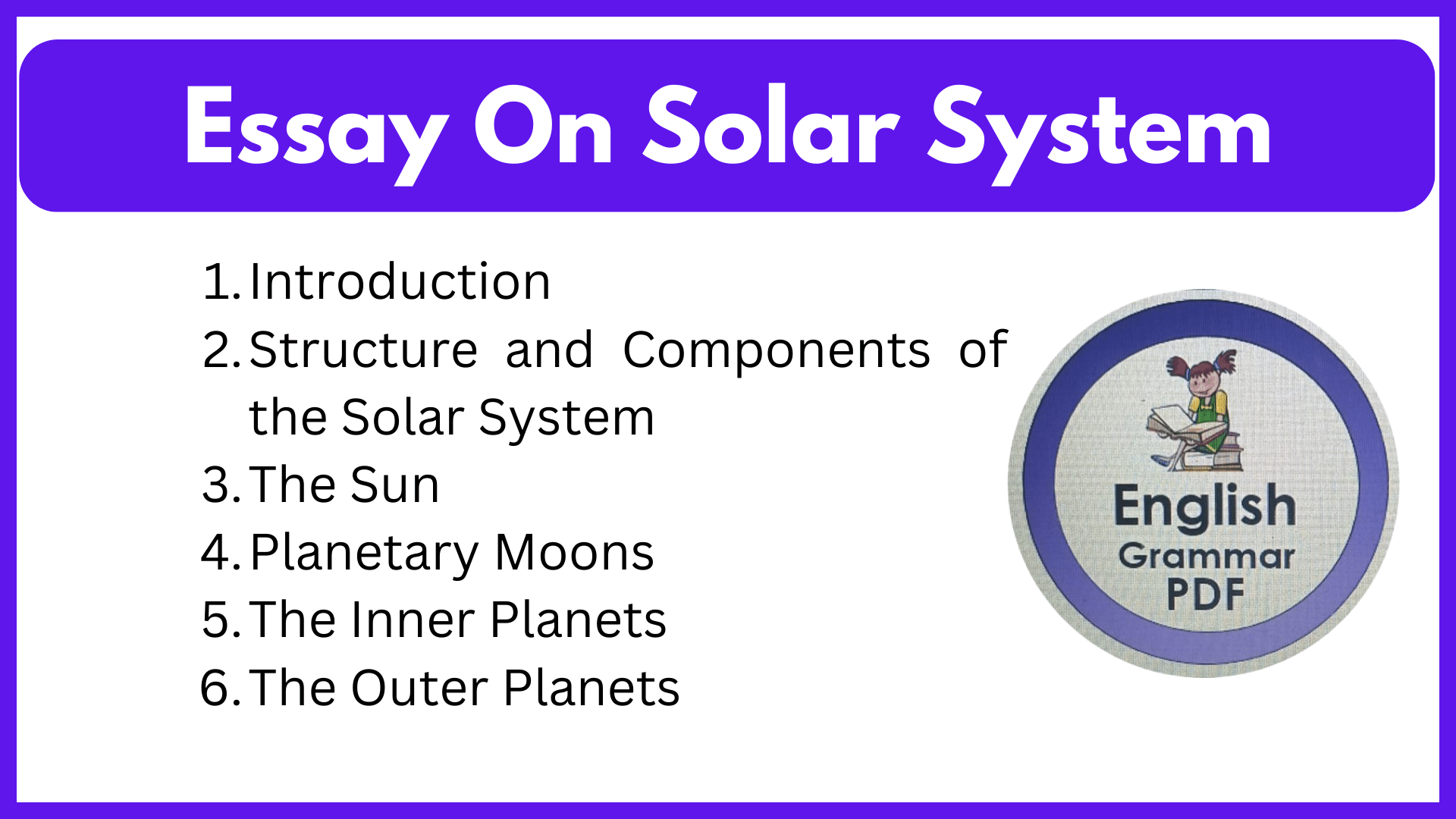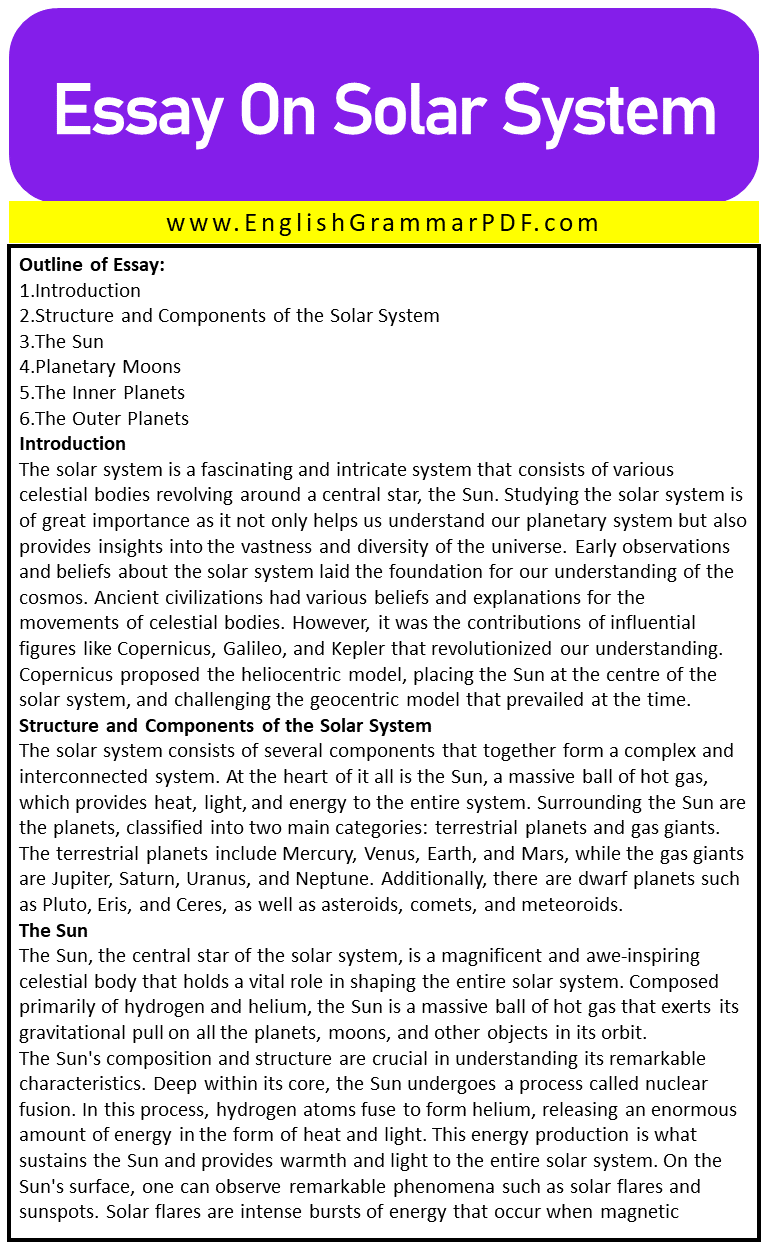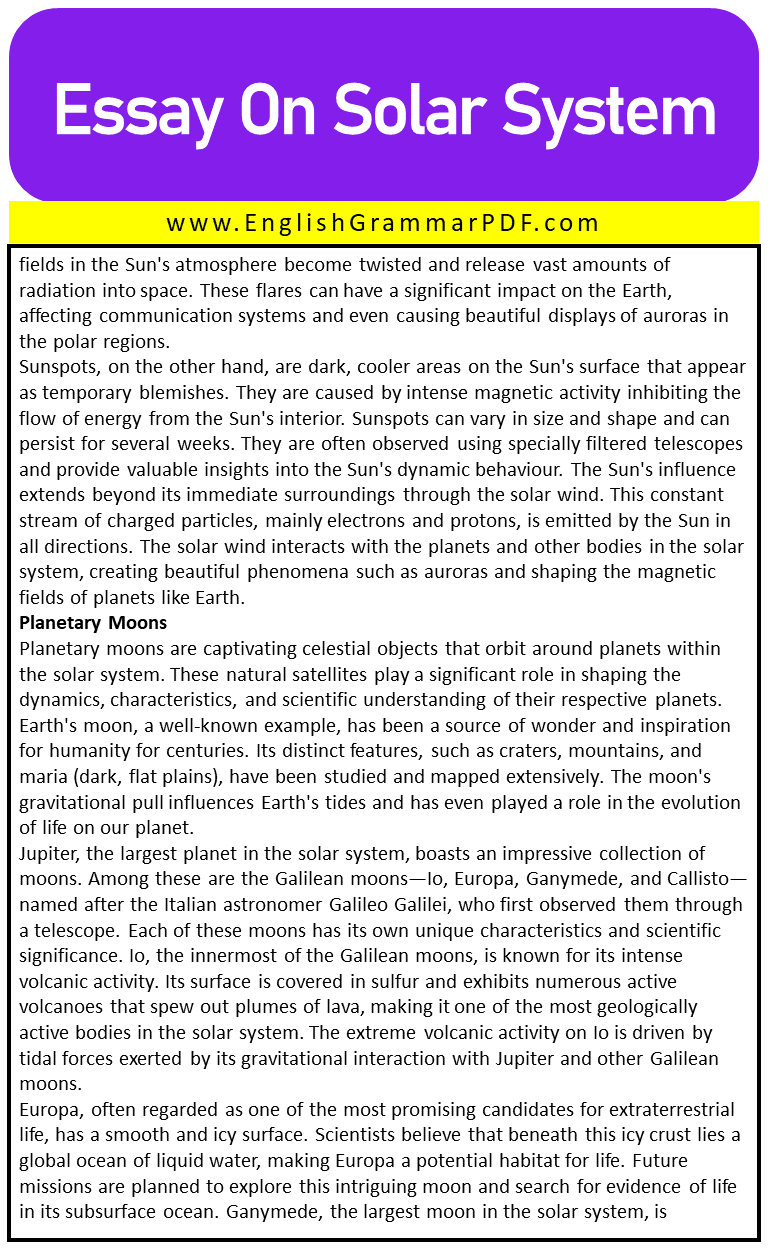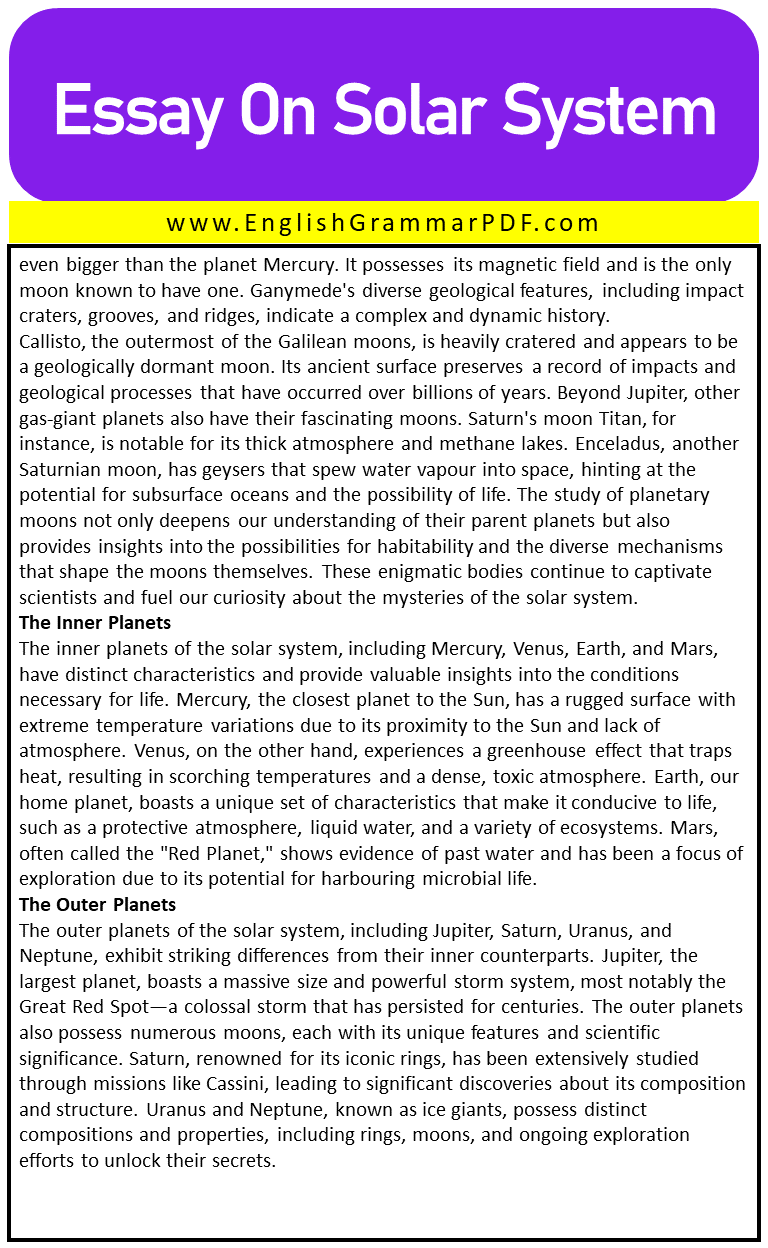Essay On Solar System
Outline of Essay:
- Introduction
- Structure and Components of the Solar System
- The Sun
- Planetary Moons
- The Inner Planets
- The Outer Planets
Introduction
The solar system is a fascinating and intricate system that consists of various celestial bodies revolving around a central star, the Sun. Studying the solar system is of great importance as it not only helps us understand our planetary system but also provides insights into the vastness and diversity of the universe. Early observations and beliefs about the solar system laid the foundation for our understanding of the cosmos. Ancient civilizations had various beliefs and explanations for the movements of celestial bodies. However, it was the contributions of influential figures like Copernicus, Galileo, and Kepler that revolutionized our understanding. Copernicus proposed the heliocentric model, placing the Sun at the centre of the solar system, and challenging the geocentric model that prevailed at the time.
Structure and Components of the Solar System
The solar system consists of several components that together form a complex and interconnected system. At the heart of it all is the Sun, a massive ball of hot gas, which provides heat, light, and energy to the entire system. Surrounding the Sun are the planets, classified into two main categories: terrestrial planets and gas giants. The terrestrial planets include Mercury, Venus, Earth, and Mars, while the gas giants are Jupiter, Saturn, Uranus, and Neptune. Additionally, there are dwarf planets such as Pluto, Eris, and Ceres, as well as asteroids, comets, and meteoroids.
The Sun
The Sun, the central star of the solar system, is a magnificent and awe-inspiring celestial body that holds a vital role in shaping the entire solar system. Composed primarily of hydrogen and helium, the Sun is a massive ball of hot gas that exerts its gravitational pull on all the planets, moons, and other objects in its orbit.
The Sun’s composition and structure are crucial in understanding its remarkable characteristics. Deep within its core, the Sun undergoes a process called nuclear fusion. In this process, hydrogen atoms fuse to form helium, releasing an enormous amount of energy in the form of heat and light. This energy production is what sustains the Sun and provides warmth and light to the entire solar system. On the Sun’s surface, one can observe remarkable phenomena such as solar flares and sunspots. Solar flares are intense bursts of energy that occur when magnetic fields in the Sun’s atmosphere become twisted and release vast amounts of radiation into space. These flares can have a significant impact on the Earth, affecting communication systems and even causing beautiful displays of auroras in the polar regions.
Sunspots, on the other hand, are dark, cooler areas on the Sun’s surface that appear as temporary blemishes. They are caused by intense magnetic activity inhibiting the flow of energy from the Sun’s interior. Sunspots can vary in size and shape and can persist for several weeks. They are often observed using specially filtered telescopes and provide valuable insights into the Sun’s dynamic behaviour. The Sun’s influence extends beyond its immediate surroundings through the solar wind. This constant stream of charged particles, mainly electrons and protons, is emitted by the Sun in all directions. The solar wind interacts with the planets and other bodies in the solar system, creating beautiful phenomena such as auroras and shaping the magnetic fields of planets like Earth.
Planetary Moons
Planetary moons are captivating celestial objects that orbit around planets within the solar system. These natural satellites play a significant role in shaping the dynamics, characteristics, and scientific understanding of their respective planets. Earth’s moon, a well-known example, has been a source of wonder and inspiration for humanity for centuries. Its distinct features, such as craters, mountains, and maria (dark, flat plains), have been studied and mapped extensively. The moon’s gravitational pull influences Earth’s tides and has even played a role in the evolution of life on our planet.
Jupiter, the largest planet in the solar system, boasts an impressive collection of moons. Among these are the Galilean moons—Io, Europa, Ganymede, and Callisto—named after the Italian astronomer Galileo Galilei, who first observed them through a telescope. Each of these moons has its own unique characteristics and scientific significance. Io, the innermost of the Galilean moons, is known for its intense volcanic activity. Its surface is covered in sulfur and exhibits numerous active volcanoes that spew out plumes of lava, making it one of the most geologically active bodies in the solar system. The extreme volcanic activity on Io is driven by tidal forces exerted by its gravitational interaction with Jupiter and other Galilean moons.
Europa, often regarded as one of the most promising candidates for extraterrestrial life, has a smooth and icy surface. Scientists believe that beneath this icy crust lies a global ocean of liquid water, making Europa a potential habitat for life. Future missions are planned to explore this intriguing moon and search for evidence of life in its subsurface ocean. Ganymede, the largest moon in the solar system, is even bigger than the planet Mercury. It possesses its magnetic field and is the only moon known to have one. Ganymede’s diverse geological features, including impact craters, grooves, and ridges, indicate a complex and dynamic history.
Callisto, the outermost of the Galilean moons, is heavily cratered and appears to be a geologically dormant moon. Its ancient surface preserves a record of impacts and geological processes that have occurred over billions of years. Beyond Jupiter, other gas-giant planets also have their fascinating moons. Saturn’s moon Titan, for instance, is notable for its thick atmosphere and methane lakes. Enceladus, another Saturnian moon, has geysers that spew water vapour into space, hinting at the potential for subsurface oceans and the possibility of life. The study of planetary moons not only deepens our understanding of their parent planets but also provides insights into the possibilities for habitability and the diverse mechanisms that shape the moons themselves. These enigmatic bodies continue to captivate scientists and fuel our curiosity about the mysteries of the solar system.
The Inner Planets
The inner planets of the solar system, including Mercury, Venus, Earth, and Mars, have distinct characteristics and provide valuable insights into the conditions necessary for life. Mercury, the closest planet to the Sun, has a rugged surface with extreme temperature variations due to its proximity to the Sun and lack of atmosphere. Venus, on the other hand, experiences a greenhouse effect that traps heat, resulting in scorching temperatures and a dense, toxic atmosphere. Earth, our home planet, boasts a unique set of characteristics that make it conducive to life, such as a protective atmosphere, liquid water, and a variety of ecosystems. Mars, often called the “Red Planet,” shows evidence of past water and has been a focus of exploration due to its potential for harbouring microbial life.
The Outer Planets
The outer planets of the solar system, including Jupiter, Saturn, Uranus, and Neptune, exhibit striking differences from their inner counterparts. Jupiter, the largest planet, boasts a massive size and powerful storm system, most notably the Great Red Spot—a colossal storm that has persisted for centuries. The outer planets also possess numerous moons, each with its unique features and scientific significance. Saturn, renowned for its iconic rings, has been extensively studied through missions like Cassini, leading to significant discoveries about its composition and structure. Uranus and Neptune, known as ice giants, possess distinct compositions and properties, including rings, moons, and ongoing exploration efforts to unlock their secrets.
FAQ’s
Who named the planets?
Roman mythology is to thank for the monikers of most of the planets in the solar system. The Romans bestowed the names of gods and goddesses on the five planets that could be seen in the night sky with the naked eye.
Which planet is called the Red planet?
Mars is known as the Red Planet because iron minerals in the Martian soil oxidize, or rust, causing the soil and atmosphere to look red.
Explore More Essays:
Download the PDF of the Essay:






